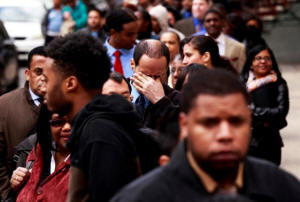|
Slower U.S. payrolls
growth dims September Fed rate hike prospects
 Send a link to a friend
Send a link to a friend
 [September 03, 2016]
By Lucia Mutikani [September 03, 2016]
By Lucia Mutikani
WASHINGTON (Reuters) - U.S. employment
growth slowed more than expected in August after two straight months of
robust gains and wages were tepid, which could effectively rule out an
interest rate increase from the Federal Reserve this month.
Nonfarm payrolls rose by 151,000 jobs last month after an upwardly
revised 275,000 increase in July, with hiring in manufacturing and
construction sectors declining, the Labor Department said on Friday. The
unemployment rate was unchanged at 4.9 percent as more people flocked to
the labor market.
The report came on the heels of news on Thursday that the manufacturing
sector contracted in August for the first time in six months, which had
already cast a shadow on a rate hike at the Fed's Sept. 20-21 policy
meeting.
Last month's jobs gains, however, could still be sufficient to push the
U.S. central bank to tighten policy in December.
"It reduces the likelihood that the Fed will raise rates in September,
but the labor market remains strong enough to
support a rate hike in December," said John Silvia, chief economist at
Wells Fargo Securities in Charlotte, North Carolina.
Economists had forecast payrolls increasing 180,000 last month and the
unemployment rate slipping one-tenth of a percentage point to 4.8
percent. The payrolls rise reinforces views the economy has regained
speed after almost stalling in the first half of the year.

Rate hike probabilities for both the September and December meetings
rose after remarks last Friday by Fed Chair Janet Yellen that the case
for raising rates had strengthened in recent months.
Financial markets on Friday were pricing in a roughly 21 percent chance
of a rate hike this month and a 54.2 percent probability in December,
according to the CME Fedwatch tool.
A Reuters survey of the big banks that do business directly with the Fed
showed 13 of the 14 so-called primary dealers expect a rate increase
this year, with only three anticipating the move this month.
The Fed lifted its benchmark overnight interest rate at the end of last
year for the first time in nearly a decade, but has held it steady since
amid concerns over low inflation.
The dollar rose against a basket of currencies, while prices for U.S.
government bonds fell. U.S. stocks ended higher.
Even though substantial labor market slack has been reduced, millions of
Americans remain unemployed, a source of frustration that could weigh on
the minds of some voters in the November presidential election.
Republican presidential nominee Donald Trump's campaign team said the
jobs numbers were a sign of a disappointing economic performance tied to
what a senior campaign adviser called "Clinton globalist policies."
But the Democratic National Committee said the employment report was
further proof of the sound economic policies of the Obama
administration. The DNC said its presidential candidate, Hillary
Clinton, was ready to build on that momentum and create an economy that
"works for everyone, not just those at the top."
CALENDAR QUIRKS RESTRAIN PAYROLLS, WAGES
The step-down in employment growth comes after the economy created a
total of 546,000 jobs in June and July.
With the labor market near full employment and the economy's recovery
from the 2007-09 recession showing signs of aging, a slowdown in job
growth is normal. According to Yellen, the economy needs to create just
under 100,000 jobs a month to keep up with population growth.
[to top of second column] |

A man rubs his eyes as he waits in a line of jobseekers, to attend
the Dr. Martin Luther King Jr. career fair held by the New York
State department of Labor in New York April 12, 2012. REUTERS/Lucas
Jackson/File Photo

The smaller-than-expected rise in payrolls also likely reflects difficulties
adjusting the data for seasonal fluctuations related to school calendars. Over
the last several years, the government's initial August payrolls estimates have
been weak only to be subsequently revised higher.
"As the August numbers have tended to come in on the softer side in the past, we
think that this mostly reflects seasonal adjustment problems rather than
underlying weakness," said Harm Bandholz, chief economist at UniCredit Research
in New York.
The timing of the next rate hike could also be determined by wage growth.
Average hourly earnings increased three cents or 0.1 percent in August after a
solid 0.3 percent rise in July.
The moderation in gains, which reflects a calendar quirk, pulled down the
year-on-year gain to 2.4 percent from an upwardly revised 2.7 percent in July,
which was the largest rise in seven years.
Americans worked fewer hours last month, with the average workweek dipping 0.1
hour to 34.3 hours. Other details of the report showed the labor force
participation rate, or the share of working-age Americans who are employed or at
least looking for a job, unchanged at 62.8 percent last month.
The participation rate remains near multi-decade lows, in part reflecting
demographic changes, partially explaining why wage growth has been sluggish.
Still, the payrolls gain added to July consumer spending, residential
construction and durable goods orders in suggesting a pickup in economic growth
after output rose 1.0 percent in the first half of the year.
A second report from the Commerce Department on Friday showed the trade deficit
fell 11.6 percent to $39.5 billion in July as soybean sales buoyed exports to a
10-month high, in another boost to the growth outlook for the third quarter.
The Atlanta Fed is forecasting gross domestic product rising at a 3.5 percent
annual rate in the third quarter.
Last month, manufacturing sector employment fell 14,000 after rising for two
straight months. Construction payrolls slipped 6,000, while mining shed a
further 4,000 jobs in August.
Professional and business services added 22,000 jobs last month after creating
80,000 positions in July. Retail sector employment increased by 15,100 jobs and
payrolls in the leisure and hospitality sector rose 29,000.

Temporary-help jobs, a harbinger of future hiring, fell 3,100. Government
payrolls rose 25,000 in August, extending the streak of job gains in the public
sector to four months.
(Reporting by Lucia Mutikani; Editing by Andrea Ricci)
[© 2016 Thomson Reuters. All rights
reserved.] Copyright 2016 Reuters. All rights reserved. This material may not be published,
broadcast, rewritten or redistributed. |